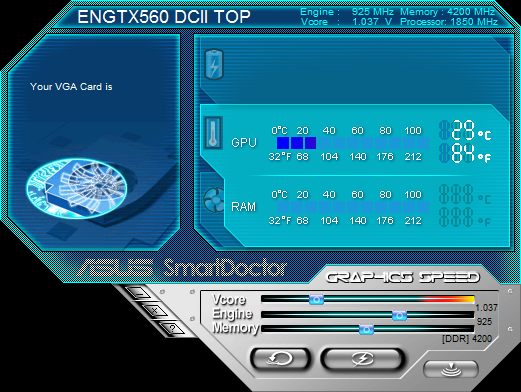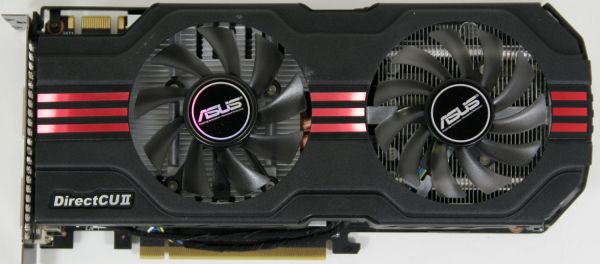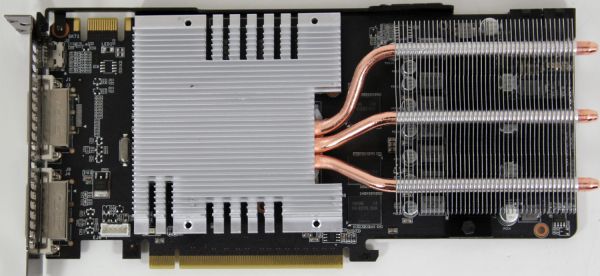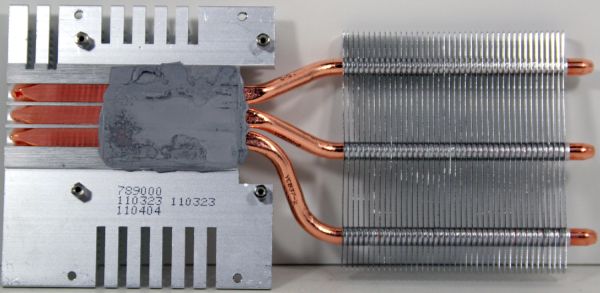NVIDIA's GeForce GTX 560: The Top To Bottom Factory Overclock
by Ryan Smith on May 17, 2011 9:00 AM ESTMeet ASUS’s GTX 560 DirectCU II Top
As we mentioned previously, the card we’re sampling today is ASUS’s GTX 560 DirectCU II Top, the faster of ASUS’s two GTX 560s, and the 2nd fastest card on NVIDIA’s launch list. It’s clocked at 925MHz for the core and 4200MHz (data rate) for the memory, giving it a sizable 115MHz (14%) core clock and 196MHz (5%) memory clock advantage over the GTX 560’s reference clocks. As we’ll see when we get to benchmarking, this is fast enough to start challenging reference clocked GTX 560 Tis.
We’ve reviewed a number of ASUS DirectCU cards in the past, but this is the first card we’ve reviewed from them that uses the DirectCU II cooler. What’s the difference? The DirectCU (I) was an open air cooler with single fan mounted at the center of the card; the DirectCU II uses two 80mm fans. In practice it’s similar to some previous coolers we’ve seen such as MSI’s Twin Frozr, however ASUS has managed to throw in their own unique adjustments.
Notably, the DirectCU II uses a different fan configuration than what we normally see with these dual-fan cards. Normally these cards are symmetrical – the left and right fans are the same. In the case of the DirectCU II ASUS is using different fans, with the left side using a taller 9 blade fan while the right side uses a more typical shorter 11 blade fan. ASUS hasn’t specifically mentioned why they do this – we’d assume they found it more efficient – but it’s an interesting deviation from what we normally see with this style of a cooler.
Removing the shroud and fans, we’re down to the actual HSF the cooler uses. ASUS has ditched the two large aluminum heatpipes running across the top of the card for a trio of smaller copper heatpipes running directly from the base of the HSF to the secondary heatsink over the rear of the card. These dual aluminum heatsink configurations are typical for dual-fan cards. Flipping the HSF over and we can see the base of the unit; ASUS has the heatpipes make direct contact with the GPU rather than using a baseplate to spread the heat out some. Both the heatpipes and the primary heatsink end up making contact with the GPU as a result.
Cooling for the VRMs is provided by small spring-loaded heatsinks attached directly to the MOSFETs. The airflow from the fans provides cooling for these heatsinks, along with some airflow over the GDDR5 memory modules to keep the card’s RAM cool.
Overall the build quality of the GTX 560 DirectCU II is up to the same solid standards we see out of an ASUS DirectCU card. ASUS continues to be the only manufacturer we see regularly using stiffening brackets with an open air cooler, making the card extremely rigid and almost impossible to flex. Even the shroud is surprisingly durable, having apparently been coated in some kind of metal or metal-like rigid plastic.
Moving on, with the factory overclock power consumption is undoubtedly higher than NVIDIA’s reference value of 150W. ASUS and other video card manufacturers don’t normally provide a TDP for the card, but we’d guess it’s around 170W, similar to that of the reference GTX 560 Ti. Providing this power is a pair of PCIe power sockets, which ASUS has helpfully oriented at the top of the card rather than the rear as we’ve seen on most other GTX 560/460 cards.
As is normally the case with ASUS DirectCU cards, the tradeoff in their design is that their cards are a bit bigger on average. Like the DirectCU (I), ASUS’ shroud is longer than the PCB itself, so while the PCB is only around 9.15” the total length of the card is just over 9.8”, versus 9” for the reference GTX 560 Ti. Meanwhile for display outputs, ASUS is following the typical NVIDIA design: 2x DVI ports and a single mini-HDMI port.
Rounding out the package, ASUS includes their usual collection of utilities: GamerOSD and SmartDoctor. SmartDoctor hasn’t changed since the last time we’ve looked at it; it still provides a passible but ultimately dated GUI for monitoring and overclocking the card. ASUS is offering voltage tweaking on this card for overclockers looking to push the card higher than 925MHz, so overvolting through SmartDoctor is a necessity for getting much farther than 925MHz. A good GF114 GPU should be able to hit near 1GHz with some extra voltage, though in our case we were only able to push our card to 950MHz, even at 1.075v.

The rest of the collection is your usual pack-in fare: a multi-language quick setup guide, a mini-HDMI to HDMI dongle, 2 molex-to-PCIe power adapters, and a DVI-to-VGA dongle.
Finally, as the GTX 560 DirectCU II Top is ASUS’s top-tier GTX 560, it also has a top-tier price: ASUS is charging an additional $20 over the GTX 560 OC, for an MSRP of $219.














66 Comments
View All Comments
Ryan Smith - Tuesday, May 17, 2011 - link
We always include MIRs in our pricing, given their prevalence. With MIRs, there are no fewer than 6 6870s at Newegg below $180 (and a 7th at $183).C'DaleRider - Wednesday, May 18, 2011 - link
"I don't know where you guys are getting this information, but the Radeon HD 6870 IS NOT at $180."Actually, I don't know where YOU are getting your misinformed information.
Right now, on Newegg, 6870's are as low as $162 after rebate, $182 before rebate. (An XFX card, btw.)
Take a look......
http://www.newegg.com/Product/ProductList.aspx?Sub...
Now, maybe you'll get your facts correct before posting drivel.
L. - Thursday, May 19, 2011 - link
Don't feed teh trollz ;)Stas - Wednesday, May 18, 2011 - link
Idk, I paid $160 for my Sapphire HD6870 with dual fans 2 months ago o.Oaraczynski - Tuesday, May 17, 2011 - link
...would those 'in the know' know whether games like the witcher2 and skyrim would be better off with the nvidia or amd line?TheJian - Wednesday, May 18, 2011 - link
Witcher 2 doesn't use Aurora engine, all new now so wait for it to be put in some sites benchmarking. Same with skyrim, it uses a new Creation engine, and also 100% dynamic lighting with lots of snow and cliffs (which this engine is designed for).Sorry. Not much worth extrapolating other than we have no idea who will win later :) If we're being honest anyway. I suppose a quick google might get a hit on the devs opinions.
Sunsmasher - Tuesday, May 17, 2011 - link
Your comments about confusing naming are very valid.I've long ago come to the conclusion that the confusing naming issue is a deliberate strategy by Nvidia.
They WANT to create confusion to make it more difficult for less sophisticated buyers
to compare cards head to head and Nvidia can thereby pick up a few more sales than they would otherwise.
The proof that this is deliberate is the fact that they Keep Doing It.
Otherwise, they would have very straightforward, very easily compared naming conventions:
Higher numbers = more power, GT not as powerful as GTX, etc.
An unfortunate state of affairs, but not about to change even with writers often complaining about it.
Fortunately, there are resources on the web that compare cards head to head.
TheJian - Wednesday, May 18, 2011 - link
They're not trying to confuse you. They're just trying to sell every chip they can. A lot of dies have defects etc that cause them to release a plethora of cards at different speeds, features disabled (possibly due to defects in dies) etc. Die shrinks cause problems too. Sometimes they save enough in power/heat to warrant a new release # or model. Take the GTX 260. The core216 came out, fixed heat issues and was a good 10% faster. People would want to identify the faster/cooler cards and not get screwed. I hate Motherboard makers not listing the REV prominently on the box, or in ads. It's tough to buy online when I'm after a specific rev. This is more a tech issue than a company deliberately ticking us off.If you don't mind paying MUCH higher prices, they can go ahead an toss all defective dies and get back to 3 product lines with easily seen performance advantages between the 3. AMD, Intel, Nvidia, etc they all have this problem. Of course progress would really slow down if they take this route. A person going into the store and seeing a 6750 card, might find a 5850 sitting next to it for $200 and wonder what the heck is going on...LOL. I could almost say the same about the 6850. That 6850 should blow away a 5850, I mean its a whole 1000 higher right? Confusing yes? But that 5850 beats the 6850 by about 10% in everything. There are a lot of these examples. Heck this time NV let the manufacturers decide everything (clock/memory/ref design).
In an age of small margins, just about everything in your PC being a commodity, and shareholders demanding every last dollar they can get from company X, you should just get used to tons of products not performing too differently. Really, I can make up my mind in one night of reading reviews on 3-4 websites. By the end of the night I can decide how to spend my money and be fairly certain I'm not making a big mistake. But yeah, if you're not willing to do some homework, get ready to buy something that's completely disappointing on occasion. But you're already here, no worries :) We have hardware review sites, because stores shelves and floor reps at fry's don't help us at all... :) I pity marketing dept's trying to work with all these dies/re-launches/binning etc that probably cause them nightmares...LOL Could they do better here and there? Probably. Would I like to try to make us all happy? HECK NO. :) I take that back, I wouldn't mind taking a crack at intel naming. :)
sysdawg - Tuesday, May 17, 2011 - link
Ryan,Thanks for your reviews. On page 3 you write "on the ATI side we’re using the Catalyst 11.5a hotfix"...but is that the case for all the AMD cards? The same page lists three drivers being used: Catalyst 10.10e, 11.4, and 11.5a. And for the Nvidia cards, you also list three drivers: 262.99, 270.51 beta, and 275.20 beta. If you could help, I'd specifically like to know which drivers were used for the GTX 580 and the Radeon 6970. And since I'm going to be running at 2560x1600, it would also help to know which drivers were used for those 2 cards in your March 24 review (of the GTX 590), since that review included that resolution. My thinking is that if the drivers are reasonably current for both cards, then it is closer to being 'apples to apples'.
Thanks in advance, and thank you again for your reviews.
Ryan Smith - Wednesday, May 18, 2011 - link
Cat 10.10e: Radeon 3xxx/4xxx.Cat 11.4: Radeon 5xxx/6850/6970
Cat 11.5: Radeon 6870/6950
262.99: GeForce 2xx
270.51: GeForce 4xx, 580/570/550
275.20: GeForce GTX 560 Ti, GTX 460, GTX 560
As for the March 24th review of the GTX 590, all the high end cards were on 266/267 drivers or the Catalyst 10.4 preview drivers respectively. Those were the newest drivers at the time of that publication.
And I apologize for the somewhat chaotic nature of the driver selection. We benchmark many different cards, redoing them for every single driver revision simply isn't practical. The relevant cards will be updated for any given article, and many (if not all) of the cards are updated if there's a major driver release that significantly impacts performance.